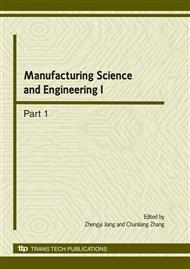p.578
p.582
p.586
p.591
p.597
p.601
p.605
p.610
p.615
Influence of Surface Friction Mismatch on Front End Bending during Plate Rolling
Abstract:
Asymmetrical conditions that occur during plate rolling can cause front end bending or lead to poor product shape, profile, quality and cause reduced productivity. In these investigations, a model of calculating curvature is deduced according to the theory of rolling, which has been used to determine the effect of surface friction mismatch on the direction and severity of curvature in plate rolling. Results show that the front end bending can occur easily due to the mismatch of coefficient of friction. Moreover, the results have identified that the bending inclination of large reduction, large radius of roll and thin rolling stock is higher than that of the reverse, the bending inclination of the entrance thickness of rolling stock is higher than that of the reduction, and the bending inclination of the reduction is higher than that of the radius of roll.
Info:
Periodical:
Pages:
597-600
Citation:
Online since:
March 2010
Authors:
Price:
Сopyright:
© 2010 Trans Tech Publications Ltd. All Rights Reserved
Share:
Citation:


